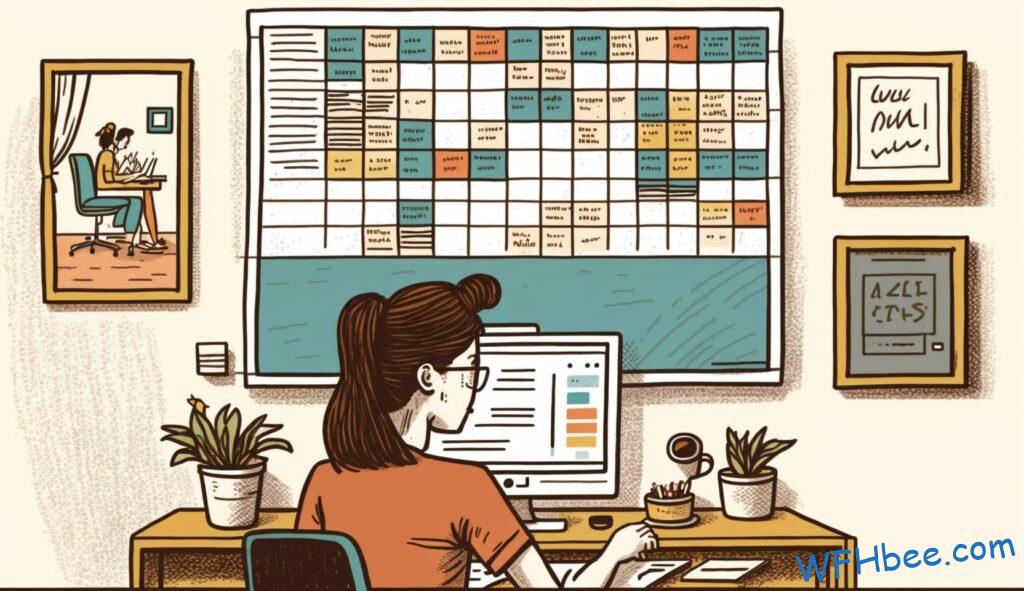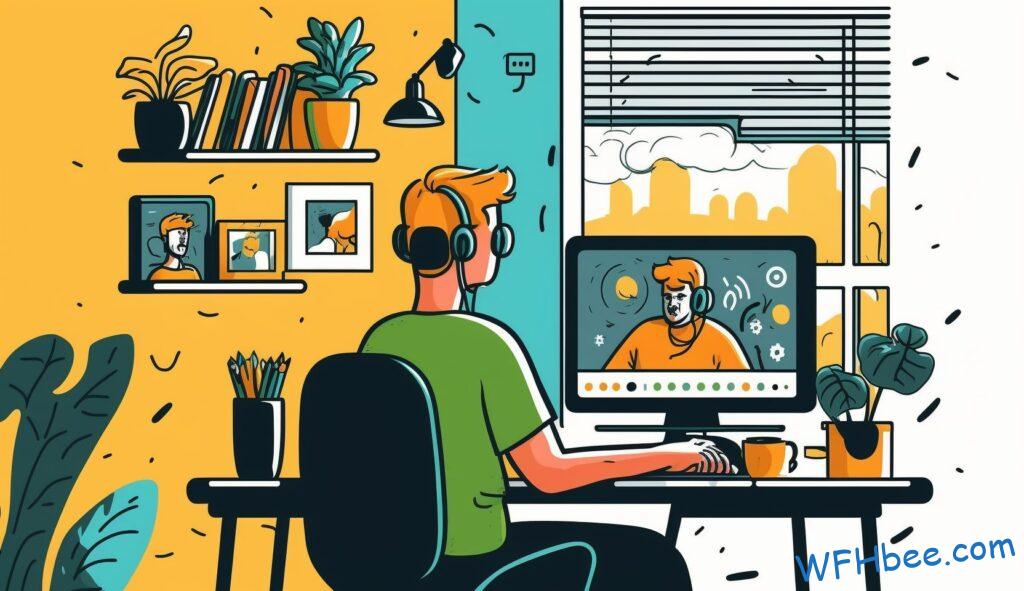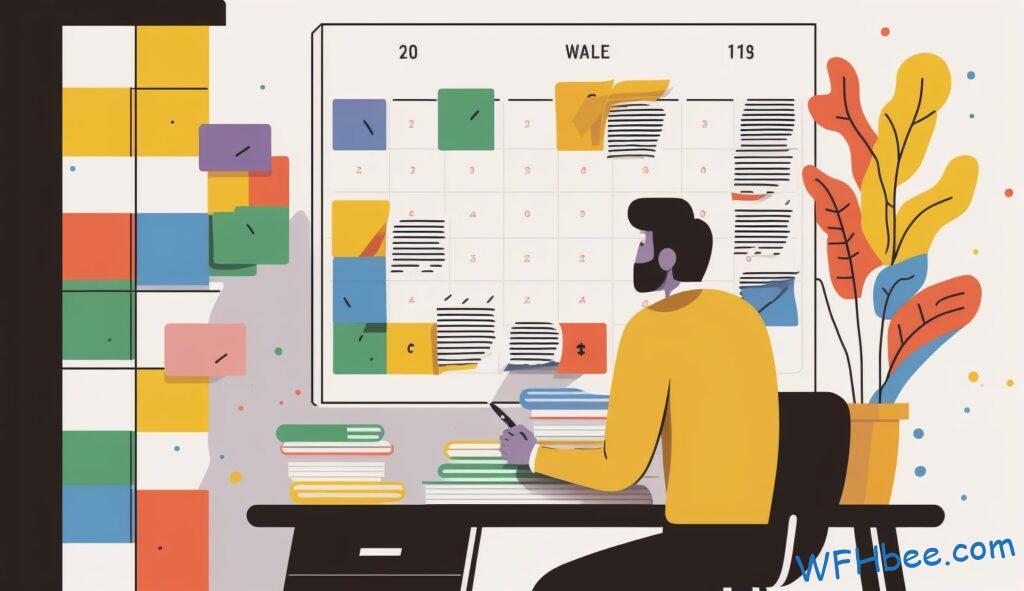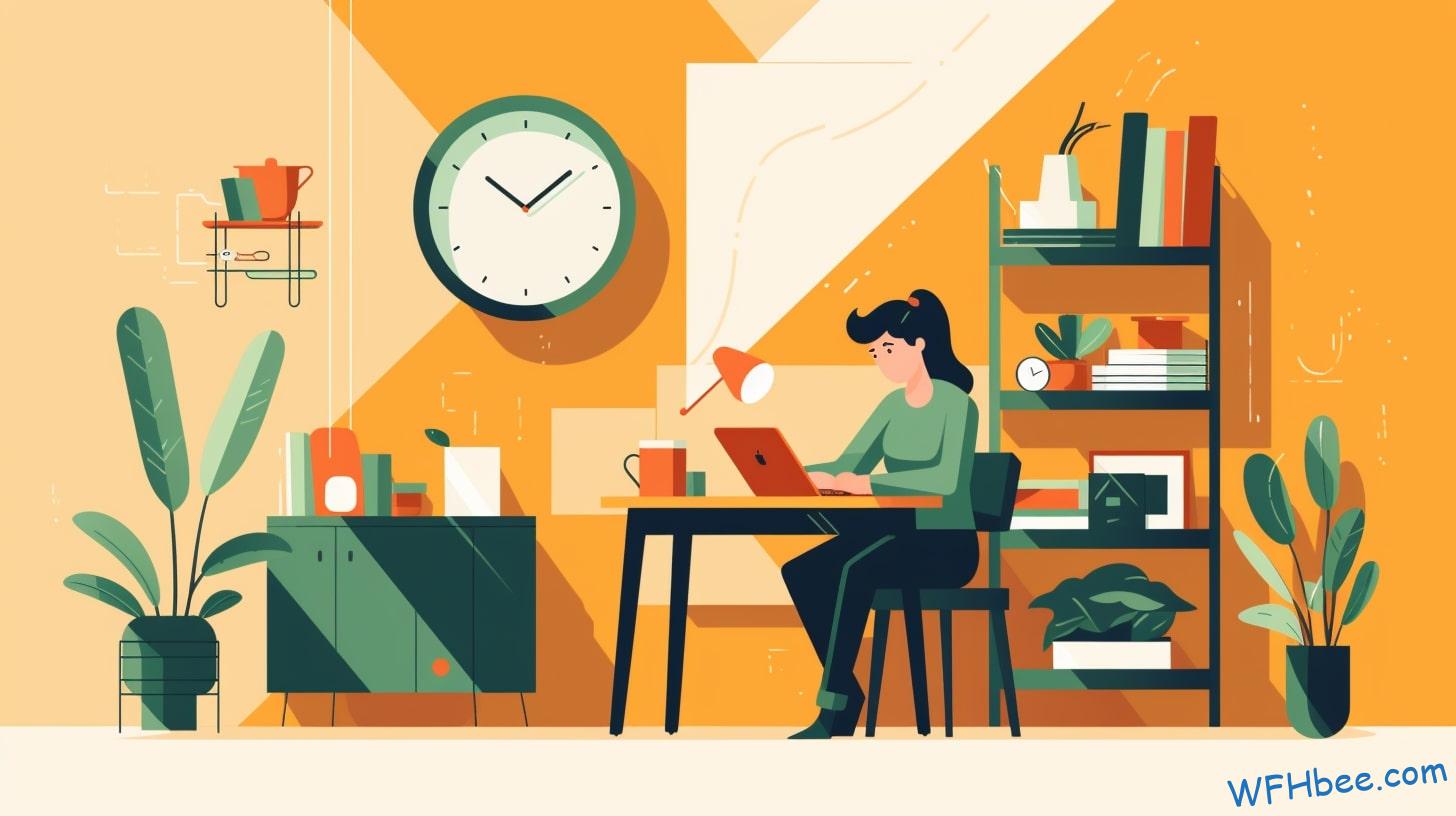Working from home has many advantages, but it also presents some unique challenges. One of the biggest is how to structure breaks in order to stay productive and take advantage of all that working from home offers. It takes time, effort and creativity to come up with a break system that works for you and fits into your schedule.
For those who are looking for a way to effectively manage their workday while still having fun and taking advantage of newfound freedom, there are several tips that can help make sure your breaks don’t run away with you! Whether you need a quick five-minute breather, want to plan an hour-long lunch outing nearby, or a mid-day gym visit, here’s what you should keep in mind when structuring your breaks at home.
From scheduling specific times throughout the day for leisurely activities like reading or listening to music, to getting outside for a walk around the block – these strategies will ensure you have sufficient downtime without sacrificing productivity during your work hours. So if you’re ready to make the most out of every moment spent away from the office, let’s dive in and explore different ways to structure breaks when working from home!

We will go through the following topics in this post:
Table of Contents

Definition Of Working From Home
Working from home is a lifestyle that allows people to work remotely, without an office setting. It involves telecommuting jobs and remote working for companies that give their employees the freedom to do so. This type of job is becoming increasingly popular due to its flexibility and convenience.
The advantages of working from home are numerous; it gives workers more control over their hours, allows them to be in charge of their own schedule, as well as provides a balance between professional and personal life that many traditional office-based jobs lack. Furthermore, with no commute time or expensive business attire needed, employers can save money on overhead costs while still providing quality service.
However, one challenge faced by those who choose to work from home is staying motivated and organized during long stretches away from the office environment. Without structure or regular breaks throughout the day it can become difficult to stay productive when there are no colleagues around you or deadlines looming ahead. That’s why it’s imperative to create boundaries and set clear expectations when structuring your break times while working from home.

Benefits Of Structured Breaks
The immense benefits of structured breaks when working from home are extraordinary! From increased productivity to improved mental health, taking a few minutes away from the computer can make all the difference in how you feel and how much work you accomplish.
First and foremost, taking scheduled breaks increases your efficiency. Allowing yourself to take a pause for even five minutes gives your brain time to rest and recharge so that it can provide better focus on whatever task comes next. You’ll find that those short moments of respite will help you concentrate more intently once you resume work, thus improving overall productivity.
Another great advantage of breaking during your day is that it helps keep stress levels at bay. Not only does this reduce potential burnout but also allows us to come back refreshed with new ideas and perspectives we may not have considered before. Working from home can become monotonous without these necessary pauses; however, by giving yourself permission to step away every now and then, your concentration level stays high and motivation remains intact throughout the day.
Structured breaks don’t just affect our professional lives either; they positively influence our personal well-being too. By allowing ourselves a break here and there, we’re able to spend quality time engaging in activities that bring us joy such as reading or spending time with family members or friends – something many people miss out on while stuck behind their computers all day long trying to finish projects or tasks. This practice has been proven to result in higher morale later down the line which keeps spirit up amidst challenging times like this pandemic period where most of us are confined within our homes indefinitely.
All in all, having some structure built into our days when working remotely offers countless advantages both professionally and personally – making life easier for everyone involved! Taking a few moments each day off screens will ensure maximum efficiency as well as serve as an important reminder that sometimes unplugging from technology is essential for maintaining physical health along with emotional balance.
Structure Of Breaks
When working from home, it’s important to structure your breaks in a way that best fits your lifestyle and mental health. Taking regular structured breaks can help keep you focused on the task at hand while reducing stress.
One of the most important aspects of structuring breaks is exercise. Physical activity helps us to stay energized throughout our day and improve overall well-being. Exercise also helps reduce anxiety, depression, and other negative emotions associated with work overload or burnout. Consider taking short walks during your lunch break or doing some light stretching before starting each morning for optimal benefit.
Engaging in social activities is another great way to break up the monotony of a long workday. Connecting with friends or colleagues via video chat can be an excellent source of support and motivation when working from home. A quick check-in with colleagues can provide a much-needed boost of energy and positivity, while engaging in meaningful conversations can foster relationships and increase productivity over time.
Structured breaks are key when working from home as they can help maintain focus and prevent burnout. Consistent physical movement and social interaction have both been proven to positively impact mental health which will ultimately lead to greater success in one’s career endeavors. So take those necessary steps today: get out of that chair, move around, interact with others—your mind will thank you!

Prioritizing Breaks In Your Day
Working from home can be a rewarding experience, but it also presents its own unique challenges. One of the greatest is finding ways to structure breaks into your day. While this may sound simple, when working in an office environment there are usually more distractions and opportunities for taking time during the day. When you’re at home all day, however, it can be easy to forget about necessary self-care strategies like taking regular breaks.
Prioritizing breaks while working from home doesn’t have to be complicated or overwhelming. Starting small by scheduling a few short breaks throughout the day can make a big difference in productivity and well-being. Setting reminders on your phone or computer will help ensure that you take these breaks regularly and don’t get too caught up in work tasks. Additionally, planning activities such as stretching exercises, quick walks outside, or chatting with friends online can provide much needed relief when trying to stay focused while working remotely.
Finally, making sure that you’re getting enough rest each night is essential for maintaining good mental health while working from home. Establishing clear boundaries between your professional and personal life will help prevent overextending yourself and burning out quickly. Taking steps towards creating a sustainable routine around prioritizing breaks throughout the day will enable you to make the most out of your remote work experience without sacrificing your physical and emotional wellbeing.

Taking Mental Health Breaks
When it comes to working from home, taking mental health breaks is essential. With this in mind, we’ve put together a few strategies for incorporating these types of breaks into your day.
First and foremost, plan ahead! Take some time each week to schedule out days off or even just afternoons off. Not only will you be able to better focus on the task at hand when you are actually working but also have something to look forward to. Knowing that you can take an afternoon break knowing that there’s no need to worry about getting back online until tomorrow can give you an extra boost of energy throughout the day.
Next, consider trying different activities during your break times such as yoga, stretching, deep breathing exercises, reading, listening to music or podcasts– anything that helps your body and mind relax and reset. For example, if you find yourself feeling overwhelmed by work tasks one morning try starting with a 10-minute yoga session before diving into emails or other projects. This way when your timer goes off you’ll feel more energized and ready to tackle whatever comes next without feeling burnt out or exhausted. Additionally, mix up what type of activity you do during each break so that it doesn’t become routine or boring.
Finally, don’t forget the importance of socializing while working from home – especially since many people may not have access to coworkers like they would in an office setting. Whether it’s chatting with friends over video call or sending funny memes via text message – taking some time away from work every now and then help keep relationships strong and morale high.

Taking Exercise Breaks
Taking regular exercise breaks when working from home is key to total wellness. Not only does it benefit our physical health, but also boosts mental and emotional wellbeing. A fitness break can be as simple or complex as you’d like – from a run around the block to an intense yoga session.
Whatever type of physical activity you choose for your exercise break, make sure it’s something that resonates with you. When taking an exercise break at home, try to focus on mindful movement – being aware of yourself and the current moment instead of zoning out. This could mean dancing freely in your living room or doing some light stretching after sitting down for long periods of time. Exercise doesn’t have to take up all your free time; fifteen minutes here and there will do just fine, while still providing great benefits over time!
No matter what kind of physical activity you’re drawn to, it should ultimately bring joy into your life without feeling like work. Whether you opt for a jog outside or a few sun salutations in front of the mirror – make sure it feels enjoyable and energizing! Taking regular breaks throughout the day not only helps us relax but also enhances productivity when we return back to work invigorated and ready to tackle new tasks.

Scheduling Social Interaction Breaks
When working from home, it’s important to take breaks for social interaction. This can help improve your mental health and break up the monotony of working alone all day. Scheduling these types of breaks is essential if you want to make sure they happen regularly while still allowing yourself time to work on projects or tasks.
One way to structure breaks for social interaction when working from home is by setting a timer each hour or two as a reminder to step away from the desk and reach out to someone in your life. Whether this be via text message, video call, phone call – whatever works best for both parties. It’s also helpful to carve out dedicated times throughout the week for longer conversations with friends or family members so that you can catch up without feeling like there isn’t enough time in between other commitments.
Having consistent communication with people during your work hours will help keep you connected, motivated, and mentally healthy. Setting reminders at regular intervals can prevent loneliness from creeping in too much and offers an opportunity to share any challenges that may have arisen since speaking last – even just having something short but meaningful will make such a difference!

Setting Time Limits For Breaks
Ah, the freedom of working from home! Every morning when you wake up, you can take in a deep breath and feel energized knowing that today is yours to conquer. You don’t have to worry about rushing out the door on time or dealing with other people’s agendas. But while this newfound freedom may be exhilarating, it also brings its own set of challenges—like how best to structure your breaks throughout the day so that they actually help improve productivity rather than hinder it.
To make sure you get maximum benefit from taking breaks during your workday, consider setting yourself specific time limits for each one. For example, if you need an energy boost around 2 pm, allotting 15 minutes for a break might be just what you need before powering through the rest of your day. This way, instead of aimlessly browsing social media for an hour (which will leave you feeling more drained), you’re focused on getting back to work afterward because there’s only a limited amount of time available. Similarly, scheduling regular 10-minute “check-in” breaks can help prevent burnout by giving your mind and body a chance to relax without completely disengaging from your task at hand.
Finally, try not to let scheduled breaks extend beyond their allotted times simply because there are no consequences like having to rush off somewhere else afterwards; although this type of autonomy has many advantages, it can lead to sloppiness in terms of sticking to routine patterns. So remember: always prioritize self-discipline over convenience when structuring your breaks—this is key for making sure that you remain as productive as possible while still recognizing the importance of taking them every now and then!

Tips To Avoid Procrastination While On Break
Now that you have a plan for taking breaks when working from home, it’s time to make sure you don’t fall into the trap of procrastination. Unfortunately, it can be easy to get distracted and find yourself wasting your break on things like checking emails or scrolling through social media instead of actually taking a restful break. Here are some tips to aid you in avoiding procrastinating while on break:
1) Set specific goals – Before your breaks begin, set realistic goals for what needs to be completed during them. This will give you an incentive to stay focused and remind you why these breaks are important in the first place. It also gives you something achievable to look forward to once your break is over.
2) Disconnect from digital distractions – To really take advantage of your break, try disconnecting from any devices or apps that could distract you. Put away phones and laptops, turn off notifications if necessary and just focus on recharging without all these digital distractions getting in the way.
3) Take physical activities – Taking part in physical activities such as yoga or stretching during your break can help clear your mind while still allowing you to move around and keep active. You can also use this time as an opportunity to get outdoors by going for a walk or doing some gardening! Doing something physical can help pull us out of our thoughts and give us perspective on whatever we may be struggling with before returning back to work feeling energized

Taking Technology-Free Breaks
Recent studies have shown that the average person spends almost 8 hours a day using technology. With so much time spent on digital devices, it can be difficult to find a way to unplug from them and take a break when working from home. Taking regular breaks away from technology is essential for mental health and productivity. Here are three great ways to structure your no-tech breaks:
- Embrace nature: Take advantage of the outdoor spaces around you by going for walks or hikes in local parks or trails. This allows you to enjoy some fresh air and get some exercise while giving yourself an electronic-free break.
- Unwind with hobbies: Use your downtime as an opportunity to explore activities such as painting, drawing, reading, writing, cooking, playing board games, gardening, etc., which do not require any electronics at all. These hobbies will help reduce stress levels and make work more enjoyable afterwards.
- Spend quality time with family & friends: Reach out to those close to you via phone calls or video conferencing apps without having the distraction of other digital devices nearby. You’ll be able to catch up on their lives and share stories about yours during these meaningful digital-detox moments.
These tech-free breaks offer a refreshing escape from our everyday routines and provide us with invaluable opportunities for self-care and relaxation – something we often forget when working remotely. Make sure you take regular breaks throughout the day and allow yourself plenty of space for restful no-tech moments; this will ensure that both your body and mind remain healthy despite the demands of remote life!

Strategies To Stay Focused After A Break
Now that we have discussed the benefits of technology-free breaks, let’s talk about strategies to stay focused after a break. Working from home can be challenging as there are more distractions than in an office setting. Taking structured breaks is essential for managing distractions and staying productive.
When creating your own schedule for working from home, designate specific times throughout the day for taking short breaks. By having structured breaks with start and end times, you will be able to better manage stress levels and remain focused on work tasks during the rest of the day. Break length will vary depending on individual needs; however, it is important not to make them too long or frequent as this can lead to decreased productivity.
It is also beneficial to come up with ideas to engage in while taking a break so that you don’t get distracted by other activities such as checking social media or watching TV shows. Going outdoors for a walk or doing some simple stretching exercises are great ways to reduce stress and increase focus when returning back to work tasks after a break. Additionally, if possible, change locations around your house during different parts of the day – this small shift in scenery can help keep things fresh and manageable over time.
By implementing these tips into your routine at home, you can maximize both creativity and productivity while feeling energized throughout the day!

Tips For Reducing Stress During Breaks
Taking regular breaks while working from home is essential to reducing stress and maintaining productivity. It’s easy to get lost in work when you don’t have the structure of an office environment, so here are some tips for taking stress-reducing breaks that will help ensure your work remains effective and efficient.
First off, set a timer. When it comes to taking breaks at home, there won’t be anyone telling you when it’s time to take one. Set a timer on your phone or computer every hour or two to remind yourself that it’s time for a break. This helps keep you mindful throughout the day that taking breaks is important both mentally and physically.
Second, try something active during your break times. Take this opportunity to move around for a few minutes – go for a walk outside if possible, or do some stretching or yoga inside your house. Doing any kind of physical activity releases endorphins which can reduce stress levels quickly and effectively! Additionally, being outside (if possible) is beneficial because fresh air has been shown to have positive effects on mood as well as mental health overall.
Lastly, use this time away from work as an opportunity to check in with yourself emotionally. During these short periods away from screens and tasks, focus instead on how you’re feeling – whether it be happy, sad, overwhelmed etc.,and identify any underlying thoughts or feelings associated with it. Taking just 10 minutes out of each day gives ourselves permission to pause our responsibilities and spend quality “me-time” focusing solely on our own emotions without distraction – allowing us the space we need to reconnect with ourselves before getting back into work mode once again!

Managing Distractions During A Break
When working from home, it can be difficult to stay focused and avoid distractions. Taking regular breaks throughout the day is essential for maintaining a healthy work-life balance. But if you’re not careful, your break time could become just another source of distraction. It’s important to structure your breaks in ways that allow you to rest without getting sidetracked by unrelated tasks or activities.
One way to do this is by setting specific goals for yourself during each break period. Decide ahead of time how long your break will last as well as what activities you want to accomplish while taking it – such as stretching, refilling your water bottle, or picking up something to eat. This helps ensure that each break serves its intended purpose of restoring both physical and mental energy instead of distracting you further.
Additionally, consider assigning certain times of the day exclusively for leisure activities like browsing social media, playing video games, watching TV, etc., so these activities don’t encroach on your scheduled breaks. Knowing when those ‘down’ moments are coming up can help alleviate some of the temptation that comes with trying not to get distracted when taking a structured break from working from home.
By managing distractions during planned breaks, you’ll gain more control over how productive and efficient you are when tackling projects at home – helping make sure nothing gets lost in between all the other things competing for attention.

Determining The Right Type And Length Of Break For You
When working from home, it can be easy to forget to take breaks. Taking a break is essential for maintaining your productivity and well-being. With that in mind, you should make sure you structure your breaks correctly so they’re most beneficial for you. Absolutely sky-rocketing above all else is determining the right type and length of break for yourself.
The first step in deciding what kind of break works best for you is understanding what types of activities energize or relax you. For some people, this could mean taking a walk outside, listening to music, reading a book, or doing something creative like painting or baking. While others may prefer meditating, journaling, stretching exercises, or even just watching TV for a few minutes. Regardless of what activity suits you best, it’s important to determine which one gives your body and mind an energy boost when needed and helps calm down stress levels when feeling overwhelmed.
Once you know the type of break that works best for you, it’s time to decide on its length. This will depend heavily on how much time each task takes as well as any commitments such as meetings throughout the day. A good rule of thumb is to take at least 15 minutes every two hours depending on your workload but if possible try not to exceed 1 hour per day – both are manageable goals that won’t interfere with your work schedule too much yet will still give you enough space to reset mentally and emotionally between tasks.
No matter what type and length of break works for you – whether it’s 15 minutes every 2 hours or 45 minutes once daily – ensure that these moments become part of your routine so that restorative pauses become second nature while working from home!

Tracking Your Progress With Structured Breaks
Now that you’ve determined the right type and length of break for yourself, it’s time to start tracking your progress with structured breaks. Working from home can be fulfilling but also challenging when it comes to taking routine pauses throughout the day. It is important to create a structure for your breaks that will help keep you focused and productive.
One way to do this is by setting up reminders on your phone or calendar app so you don’t forget about them. This strategy allows you to stay organized and ensure that you are scheduling regular intervals between tasks. Additionally, having an accountability partner who checks in with you during work hours may make all the difference in helping maintain focus on projects while still getting ample restorative downtime throughout the day.
Taking specific moments during the day to pause and reflect on what has been accomplished can be beneficial for both physical and mental health. Structured breaks not only provide an opportunity to reenergize but they also offer insight into how much progress is being made towards completing a task or project. When we track our progress with planned rest periods, we gain clarity as well as a sense of accomplishment which further motivates us to continue doing great work!

Conclusion
Working from home can be a great way to stay productive and organized, but it’s important to take breaks. Structured breaks are essential for maintaining mental health and staying on top of your work tasks. Taking the time to prioritize and plan out your breaks helps ensure that you’re able to make the most of them. With mindful practices like meditation or journaling, you can create an environment where taking regular breaks is rewarding and restorative.
When crafting your break structure, consider the type of activities that will help you relax and recharge in order to get back into work mode feeling refreshed. Remember that everyone has different needs when it comes to how long their break should last; focus on what works best for you instead of comparing yourself with others. You’ll find that investing in this practice pays off as increased productivity and creativity come along with it!
Finally, track your progress so that you can adjust as needed. There is no one-size-fits-all approach when it comes to structuring breaks while working from home, so don’t be afraid to experiment until you find something that feels right for you. Keeping structured breaks integrated within your daily routine will improve both your physical and mental wellbeing – allowing yourself this time away ensures greater success down the line!
Author: Robin Borg
Hi, I’m Robin. I have been working from home at least one day a week during all of my adult life. I have a background in research and data science. Get to know me better in the About page.







